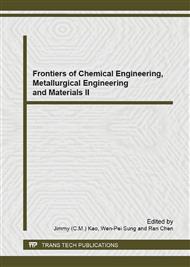p.278
p.285
p.289
p.295
p.300
p.308
p.312
p.317
p.321
Experimental Investigation of Fine Particles Classification Properties in Gas-Solid Multilevel Particular Fluidization Tower
Abstract:
The fine particles classification properties in a gas-solid multilevel particular fluidization tower (MPFT) with the rectangular body of 2.4 m in height and 0.032 m2 in cross sectional area, five tower plates of 0.39 m in length and 0.08 m in width and 0.005 m in thickness were investigated using two different properties particles, talc particle and quarts sand particle, as solid phase and air as gas phase. It was found from the experimental results that the pressure drop increases with increasing superficial gas velocity. And the spread of pressure drop was gradually decreased from top to bottom in the tower. The grade efficiency for talc powder particle (dp = 10 μm) attained 78.78% and d95 reached 12.84 μm at Ug = 0.122 m/s. Meanwhile, for quartz sand particle (dp = 10 μm), the grade efficiency attained 92.80% and d95 reached 12.58 μm at Ug = 0.139 m/s. The grade efficiency for the two different properties particles both increases with decreasing feed rate at these experimental conditions in this work. The particle size distribution range of overflow particle increases a little with increasing circulating gas velocity. The grade efficiency for quartz sand particle (dp = 10 μm) dropped from 92.56% to 82.70% with increasing different regurgitant rates from 0 to 12.5 kg/h.
Info:
Periodical:
Pages:
300-307
Citation:
Online since:
September 2013
Authors:
Keywords:
Price:
Сopyright:
© 2013 Trans Tech Publications Ltd. All Rights Reserved
Share:
Citation:


